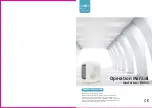
T_C-IOM-2A
8
General Information
Unit Inspection
As soon as the unit arrives at the job site
[ ] Verify that the nameplate data
matches the data on the sales order
and bill of lading (including electrical
data).
[ ] Verify that the power supply complies
with the unit nameplate specifications.
[ ] Visually inspect the exterior of the unit,
including the roof, for signs of shipping
damage.
If the job site inspection of the unit re-
veals damage or material shortages, file a
claim with the carrier immediately.
Specify the type and extent of the dam-
age on the “bill of lading” before signing.
[ ] Visually inspect the internal compo-
nents for shipping damage as soon as
possible after delivery and before it is
stored. Do not walk on the sheet metal
base pans.
[ ] If concealed damage is discovered,
notify the carrier’s terminal of damage
immediately by phone and by mail.
Concealed damage must be reported
within 15 days.
Request an immediate joint inspection
of the damage by the carrier and the
consignee. Do not remove damaged
material from the receiving location.
Take photos of the damage, if pos-
sible. The owner must provide rea-
sonable evidence that the damage
did not occur after delivery.
[ ] Notify the appropriate sales represen-
tative before installing or repairing a
damaged unit.
Storage
Take precautions to prevent condensate
from forming inside the unit’s electrical
compartments and motors if:
a. the unit is stored before it is installed;
or,
b. the unit is set on the roof curb, and
temporary heat is provided in the
building. Isolate all side panel service
entrances and base pan openings
(e.g., conduit holes, S/A and R/A
openings, and flue openings) from the
ambient air until the unit is ready for
start-up.
Note:
Do not use the unit’s heater for
temporary heat without first completing
the start-up procedure detailed under
“Heating Start Up”.
The manufacturer will not assume any re-
sponsibility for equipment damage re-
sulting from condensate accumulation on
the unit’s electrical and/or mechanical com-
ponents.
Unit Clearances
Figure 1 illustrates the minimum operating
and service clearances for either a single
or multiple unit installation. These clear-
ances are the minimum distances neces-
sary to assure adequate serviceability,
cataloged unit capacity, and peak operat-
ing efficiency.
Providing less than the recommended
clearances may result in condenser coil
starvation, “short-circuiting” of exhaust
and economizer airflows, or recirculation
of hot condenser air.
Содержание Precedent TSC060
Страница 25: ...25 T_C IOM 2A Installation Figure 6 Typical Field Wiring Diagrams for Optional Controls ReliaTel only...
Страница 42: ...T_C IOM 2A 42...
Страница 43: ...43 T_C IOM 2A...









































